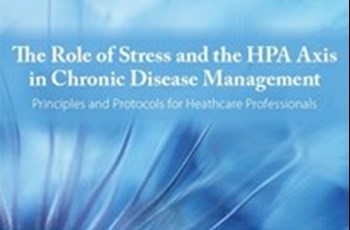
It would not be an exaggeration to say that this book covers everything you need to know about the stress response system and how it affects our health.
Dr. Guilliams reminds us that only 80 years ago the concept of stress as a biological process, and how the stress response is regulated by the hypothalamus-pituitary-adrenal (HPA) axis, was yet to be elucidated. He takes us back to the pioneering discoveries of Hans Selye, who in 1936 published a letter in Nature entitled "A syndrome produced by diverse nocuous agents" and went on to describe the body’s response to stressors in terms of what he called a "general adaptation syndrome" in a monograph published in 1950.
While Dr. Selye certainly didn’t have all the answers, he laid the foundations for what became a vast area of research into phenomena that touch every biological system and affect every aspect of our health.
This book offers a clear, well-illustrated review of the HPA axis, explaining how each of its components work and how they interact together, and how dysregulation of the axis impacts multiple aspects of health. He challenges some prevailing ideas, such as the nomenclature of some types of HPA axis dysfunction as "adrenal fatigue," instead suggesting more accurate terminology that better reflects what underlies it. And he reassesses the concept of "pregnenolone steal" by describing the pathways of steroidogenesis starting from cholesterol within the 3 distinct zones of the adrenal cortex, each of which produces a different hormone, and each of which is under the control of different types of receptor signaling the expression of the different enzymes required to synthesize each hormone. This clear description of steroidogenesis within the adrenal gland challenges the notion that overproduction of one hormone in one zone automatically reduces the availability of pregnenolone for hormone production by another, as if all the hormones were being produced from the same pool of pregnenolone within the same cells.
This book goes a long way to explain difficult concepts and bring clinicians up to date with the latest research. |
Dr. Guilliams describes in great detail the ways in which various kinds of stress influence the HPA axis and how each of these can be modified. These include perceived stress, involving not only the brain’s reaction to anticipated stress but also disorders of stress perception caused by neurotransmitter imbalances, manifested in conditions such as depression or anxiety. They also include sleep imbalances that affect circadian rhythms, blood sugar dysregulation, and inflammatory signaling as a result of food allergies, gastrointestinal irritation, chronic inflammatory diseases such as rheumatoid arthritis, and obesity.
Aimed at clinicians hoping to better understand and treat HPA axis dysfunction, the book describes laboratory assessments of the HPA axis and explains how to interpret results. It details lifestyle approaches as well as some natural therapeutic protocols that can improve outcomes, including the use of adaptogens and related botanicals. Current research on the effects of physical activity on the HPA axis is summarized, to explain the biological basis for the known benefits of moderate exercise for a wide variety of medical conditions.
For those wishing to have a better understanding of the stress response and the HPA axis, and who have little time to review and synthesize the vast scientific literature on this topic, this book goes a long way to explain difficult concepts and bring clinicians up to date with the latest research. While short enough to be a manageable read, it opens the doors for further investigation of therapeutic approaches that may provide new ideas (and reinforce old ones) for the practicing clinician.
Bio
Thomas G. Guilliams, PhD, earned his doctorate from the Medical College of Wisconsin where he studied molecular immunology in the Microbiology Department. Since 1996, he has spent his time studying the mechanisms and actions of natural-based therapies, and is an expert in the therapeutic uses of nutritional supplements. As the VP of Science and Regulatory Affairs for Ortho Molecular Products, he has developed a wide array of products and programs which allow clinicians to use nutritional supplements and lifestyle interventions as safe, evidence-based and effective tools for a variety of patients. Dr. Guilliams teaches at the University of Wisconsin School of Pharmacy, where he holds an appointment as a Clinical Instructor, and at the University of Minnesota School of Pharmacy, and he is a faculty member of the Fellowship in Anti-aging Regenerative and Functional Medicine (A4M).
